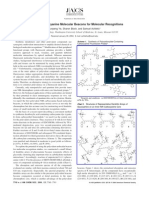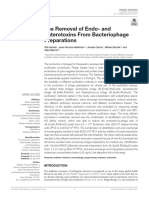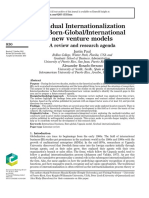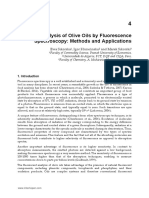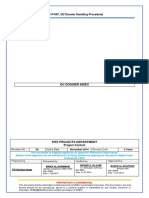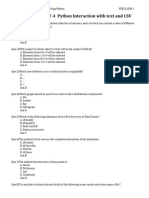100%(1)100% found this document useful (1 vote)
135 viewsAlbastru de Metilen
Albastru de Metilen
Uploaded by
Cristina Ileana CovaliuThe document summarizes a study that characterized an antiseptic composite material made of collagen, hydroxyapatite, and methylene blue for biomedical applications. The composite was obtained by co-precipitating hydroxyapatite in a collagen matrix and adding methylene blue dropwise. The composite was characterized using Fourier transform infrared spectroscopy, X-ray diffraction, and scanning electron microscopy. The release of methylene blue from the composite was monitored using UV-Vis spectroscopy. The characterization confirmed good mineralization of the collagen matrix, stability of the hydroxyapatite phase, and ability to bind methylene blue. The results showed a gradual release of methylene blue from the composite material. Therefore, the collagen-hydroxyapatite
Copyright:
© All Rights Reserved
Available Formats
Download as PDF, TXT or read online from Scribd
Albastru de Metilen
Albastru de Metilen
Uploaded by
Cristina Ileana Covaliu100%(1)100% found this document useful (1 vote)
135 views8 pagesThe document summarizes a study that characterized an antiseptic composite material made of collagen, hydroxyapatite, and methylene blue for biomedical applications. The composite was obtained by co-precipitating hydroxyapatite in a collagen matrix and adding methylene blue dropwise. The composite was characterized using Fourier transform infrared spectroscopy, X-ray diffraction, and scanning electron microscopy. The release of methylene blue from the composite was monitored using UV-Vis spectroscopy. The characterization confirmed good mineralization of the collagen matrix, stability of the hydroxyapatite phase, and ability to bind methylene blue. The results showed a gradual release of methylene blue from the composite material. Therefore, the collagen-hydroxyapatite
Copyright
© © All Rights Reserved
Available Formats
PDF, TXT or read online from Scribd
Share this document
Did you find this document useful?
Is this content inappropriate?
The document summarizes a study that characterized an antiseptic composite material made of collagen, hydroxyapatite, and methylene blue for biomedical applications. The composite was obtained by co-precipitating hydroxyapatite in a collagen matrix and adding methylene blue dropwise. The composite was characterized using Fourier transform infrared spectroscopy, X-ray diffraction, and scanning electron microscopy. The release of methylene blue from the composite was monitored using UV-Vis spectroscopy. The characterization confirmed good mineralization of the collagen matrix, stability of the hydroxyapatite phase, and ability to bind methylene blue. The results showed a gradual release of methylene blue from the composite material. Therefore, the collagen-hydroxyapatite
Copyright:
© All Rights Reserved
Available Formats
Download as PDF, TXT or read online from Scribd
Download as pdf or txt
100%(1)100% found this document useful (1 vote)
135 views8 pagesAlbastru de Metilen
Albastru de Metilen
Uploaded by
Cristina Ileana CovaliuThe document summarizes a study that characterized an antiseptic composite material made of collagen, hydroxyapatite, and methylene blue for biomedical applications. The composite was obtained by co-precipitating hydroxyapatite in a collagen matrix and adding methylene blue dropwise. The composite was characterized using Fourier transform infrared spectroscopy, X-ray diffraction, and scanning electron microscopy. The release of methylene blue from the composite was monitored using UV-Vis spectroscopy. The characterization confirmed good mineralization of the collagen matrix, stability of the hydroxyapatite phase, and ability to bind methylene blue. The results showed a gradual release of methylene blue from the composite material. Therefore, the collagen-hydroxyapatite
Copyright:
© All Rights Reserved
Available Formats
Download as PDF, TXT or read online from Scribd
Download as pdf or txt
You are on page 1of 8
66 Revista Romn de Materiale / Romanian Journal of Materials 2014, 44 (1), 66 - 73
MATERIALE COMPOZITE ANTISEPTICE PENTRU APLICAII BIOMEDICALE
ANTISEPTIC COMPOSITE MATERIAL FOR BIOMEDICAL APPLICATIONS
ANDREIA ILIE, ECATERINA ANDRONESCU
,
CRISTINA DANIELA GHIULIC
, ANDREI TIBERIU CUCURUZ
Universitatea Politehnica Bucureti, Str. G.Polizu, 011061, Bucureti, Romnia
The scope of the present work was to study
the release of methylene blue from a composite material
based on collagen and hydroxyapatite.
The obtaining of the composite material was
achieved by co-precipitation of hydroxyapatite in the
collagen matrix (at a pH of 10.5). Later, methylene blue was
added dropwise because the composite material is intended
to act as support for releasing methylene blue; the release
of methylene blue ensuring the antiseptic nature of the
material.
The composites were then characterized by: Fourier
transform infrared spectroscopy (FT-IR), X-ray diffraction
(XRD), scanning electron microscopy (SEM) while the
release process was monitored by UV-Vis spectroscopy.
The characterization of the collagen/hydroxyapatite
composite material revealed a good mineralization of
collagen matrix a high stability of the mineral phase, as well
as the capacity to bind/absorb methylene blue.
From the point of view of the release process, the
results showed a gradual release that was evidenced by UV-
Vis spectroscopy, the release evolution being monitored at
a wavelength of 663 nm, characteristic.
Therefore, studies suggest the use of
collagen/hydroxyapatite composite material as support for
tissular regeneration of bone tissue, methylene blue
providing antiseptic properties.
n lucrarea de fa s-a studiat eliberarea albastru-
lui de metilen dintr-un material compozit de tip colagen-
hidroxiapatit.
Obinerea materialului compozit s-a realizat prin
coprecipitarea hidroxiapatitei n matricea colagenic (la un
pH de 10,5). Ulterior a fost adugat albastru de metilen prin
picurare, materialul compozit dorindu-se a avea rolul de
suport pentru eliberarea albastrului de metilen; eliberarea
albastrului de metilen asigurnd caracterul antiseptic al
materialului obinut.
Materialele obinute au fost caracterizate prin:
spectroscopie de IR cu transformat Fourier (FT-IR),
difracie de raze X (XRD), microscopie electronic de baleiaj
(SEM), n timp ce procesul de eliberare a fost monitorizat
prin spectroscopie UV-Vis.
Caracterizarea materialului compozit colagen-
hidroxiapatit a evideniat o bun mineralizare a matricii
colagenice, o stabilitate mare a fazei minerale, precum i
abilitatea de a lega/absorbi albastru de metilen. Din punct
de vedere al procesului de eliberare, rezultatele au artat o
eliberare treptat care a fost pus n eviden cu ajutorul
spectroscopiei UV-Vis, evoluia eliberrii fiind urmrit la
lungimea de und de 663nm, caracteristic.
Prin urmare, studiile realizate sugereaz o posibil
utilizare a materialului compozit de tip colagen-
hidroxiapatit ca suport pentru regenerarea tisular a
esutului osos, albastru de metilen asigurnd proprieti
antiseptice.
Keywords: hydroxyapatite, collagen, drug release, methylene blue
1. Introduction
Drug delivery systems (DDS) are new tools
with applications both in the fields of industry and
medicine.
Drug delivery is a domain of high importance
for medicine and healthcare [1-6]. A wide range of
improvements can occur by controlling drug
delivery: bioavailability, by preventing premature
degradation and enhancing uptake, the number of
side effects will decrease by targeting exactly the
diseased cells and sites, and a constant drug
concentration by controlling the drug release rate.
Many synthetic biomaterials were tested as
bone graft materials but the most promising of them
seems to be the collagen (Coll)/hydroxyapatite (HA)
(nano) composite materials because because of the
similarity with natural bones [7-9].
Calcium phosphate-based bioceramics such
as hydroxyapatite (Ca
10
(PO
4
)
6
(OH)
2
) are well-
known for their excellent biocompatibility due to
the resemblance in composition with apatite found
in natural bones [10-12].
Research studies have been done using HA
with the purpose to deliver stem cell-containing
biomaterials to the sites of disease or injury to allow
bone regeneration. Although pure HA is bioactive, it
is very difficult to incorporate therapeutic agents
within HA without destroying the biofunctionality of
its surface. In order to overcome this limitation,
several composites of HA and polymers have been
developed [13-16].
Methylene blue (3,7-bis(dimethylamino)-
phenothiazin-5-iumchloride) is an
oxidation/reduction indicator with blue/gray color
that is applied both in biology and chemistry. At
room temperature, it appears as an odorless, dark
green powder and dissolution in water produces a
blue solution that is usable as redox indicator in
analytical chemistry. Methylene blue (MB) was in
Autor corespondent/Corresponding author,
E-mail: cghitulica@yahoo.com
A.Ilie, E. Andronescu, C.D. Ghiulic, A. T. Cucuruz / Materiale compozite antiseptice pentru aplicaii biomedicale 67
the past just one of the many new synthetic
chemicals used as dyes in the textile industry.
Then, further researches in this domain proved that
MB can be used in a wider range of experimental
applications.
MB is usually prescribed for urinary
infections as analgesic/anti-infective/anti-
spasmodic that is a combination of drugs which
also contains phenyl salicylate, benzoic acid,
hyoscyamine sulfate and methenamine. MB is also
used for endoscopic polypectomy as an adjunct to
saline, epinephrine and for injection into the
submucosa around the polyp to be removed. This
allows the identification of submucosal tissue plane
after removal of the polyp and is useful to
determine if more tissue needs to be removed or if
it is a high risk for perforation [17-18].
Collagen/hydroxyapatite composite materials
are widely used for hard tissue repairs; adding
methylene blue (MB) to the composites is intended
to allow avoiding infections.
2. Experimental
In this study it was used a composite
material based on collagen and hydroxyapatite
which was obtained by co-precipitation technique.
The antiseptic characteristics are assured by the
use of methylene blue.
The mineralization process was carried out
directly on the collagen matrix. The mineralization
was made by mineralization by using Ca(OH)
2
suspension and NaH
2
PO
4
solution (both purchased
from Fluka). Between the two immersions of
collagen matrix in Ca(OH)
2
suspension and
phosphate solution after draining the excess of
water, a volume of methylene blue was pippeted
on the collagen matrix surface. The entire process
is shown in Figure 3. The concentration and
volume of the Ca(OH)
2
suspension, NaH
2
PO
4
solution are presented in Table 1 and the
procentual composition of the composite material
are presented in Table 2.
The synthesized samples were
characterized by:
a) X-ray diffraction (XRD) to identify the
phases of the material and to determine their
concentration. X-ray diffraction analysis was
performed on a Shimadzu XRD 6000
diffractometer at room temperature. It was used
the Cu K radiation from a Cu X-ray tube. The
samples were scanned in the Bragg angle, 2
range of 1087
o
at a scan rate of 2
o.
min
1
.
b) Fourier transform infrared spectroscopy
(FTIR) - IR spectroscopic measurements were
performed using a Shimadzu FTIR 8400
spectrophotometer. The spectra were recorded
over the wavenumber range of 400 4600cm
-1
with
a resolution of 4cm
-1
.
c) Scanning electron microscopy (SEM)
was used to examine the microstructure of the
samples. SEM images were obtained with a
HITACHI S2600N with an EDAX probe. All
samples were covered with a silver layer prior to
imaging.
d) The release of methylene blue was
monitored by UV-Vis spectroscopy, at 663nm
corresponding to the maximum of absorption of
methylene blue. The UV-Vis spectroscopy
analyses were performed on a Thermo Scientific
Evolution 300 Spectrophotometer.
Figure 1 presents the UV-Vis absorption
spectrum recorded for the 100 ppm methylene
blue solution. The maximum absorption points of
methylene blue are found at 246, 291, 612 and
633nm.
Fig. 1 - UV-Vis absorption spectrum for methylene blue / Spectrul de absorbie UV-Vis corespunztor albastrului de metilen.
68 A.Ilie, E. Andronescu, C.D. Ghiulic, A. T. Cucuruz / Antiseptic composite material for biomedical applications
Based on the calibration curve in Figure 2,
the quantification is done at 663 nm because the
absorbance is maximum at this value and linearity
on the desired range (8 -1000 ppm) is very good.
The linearity coefficient was 0.9996.
0
0,5
1
1,5
2
2,5
3
3,5
A
b
s
o
r
b
a
n
c
e
Linearitycurveofthereleaseprocess
at663nm
Fig. 2 - Linearity curve of the release process at 663 nm / Curba
de liniaritate a eliberrii la 663 nm
Table 1
Mineralization conditions / Condiiile de mineralizare
CM
*
Concentration of Ca(OH)
2
suspension, g/L
Concentratia suspensiei de Ca(OH), g/L
0.739
Volume of Ca(OH)
2
suspension, L
Volumul suspensiei de Ca(OH), L
0.5
Concentration of NaH
2
PO
4
solution, g/L
Concentratia solutiei de NaH
2
PO
4
, g/L
0.9318
Volume of NaH
2
PO
4
solution, L
Volumul soluiei de NaH
2
PO
4
, L
0.5
* Composite material/Material compozit
Table 2
Procentual composition of Coll/HA-MB composite material
Compoziia procentual a materialului compozit Coll/HA-AM
CM
*
Coll(%) HA(%) MB
**
(%)
Coll/HA 19.8 79.2 1
** Methylene blue/Albastru de metilen
Fig. 3 - Schematic representation of the mineralization process / Reprezentarea schematic a procesului de mineralizare
3. Results and discussion
3.1. Scanning electron microscopy
Figure 4 presents SEM images for the
collagen matrix used for obtaining antiseptic
collagen/hydroxyapatite composite material. SEM
pictures show the porous structure of the material,
where both fibers and fibrils can be seen and are
useful to make a comparison with the material that
was previously analyzed. The collagen matrix is a
layered porous structure with pore size of
approximately 50 200m and the distance
between layers of about 100m.
Figure 5 presents the SEM image of the
collagen/hydroxyapatite composite material for
different magnifications. Regardless of the selected
magnification, there is a very good mineralization
of collagen matrix, the collagen/hydroxyapatite
composite being homogeneous. At lower
magnification, SEM images allow visualization of
the microstructure of the composite, being able to
identify pore sizes of 50-150 m within the layered
material. These size are optimal for bone
integration as reported by different researchers
[19].
Due to the instability of the collagenous
structure in the electron beam, the capture of
images was possible at a maximum magnification
of 3500 x which allowed just the visualization of
hydroxyapatite agglomerates and not for the
mineral phase particles, the size of the
agglomerates being smaller than 500nm.
A.Ilie, E. Andronescu, C.D. Ghiulic, A. T. Cucuruz / Materiale compozite antiseptice pentru aplicaii biomedicale 69
Figure 5 - SEM images recorded for the collagen/hydroxyapatite composite material at magnifications of 50, 100, 1000 and 3500x
Imaginile SEM nregistrate pe materialul compozit pe baz de colagen i hidroxiapatit, la mriri de 50, 150, 500, 1000 i 3500x
3.2. Fourier transform infrared spectroscopy
FTIR
IR spectroscopy is used to highlight the
presence of hydroxyapatite deposit on the collagen
matrix and chemical stability of the collagen matrix
in the mineralization process.
Figure 6 presents IR spectra of Coll/HA
composite material. The main absorption bands of
collagen are present at 1510, 1541, 1652cm
-1
, and
those of HA are 565, 604, 1032cm
-1
. The large
absorption band in the range of 3000 3600cm
-1
is related to the associated hydroxyl groups from
water, collagen and hydroxyapatite [20].
Figure 7 - shows the FTIR spectra recorded
on a collagen matrix. The reason for recording this
spectrum is to compare it with the
collagen/hydroxyapatite composite material (Figure
6) in which mineral phase can be observed by the
appearance of characteristic absorption bands at
1032 cm
-1
and those from 565 cm
-1
and 604 cm
-1
.
As it can be noticed from Figure 8, the
presence of methylene blue as antiseptic does not
influence the structure and composition of the
composite material maybe because the latter is
present in very small amount. However, it can be
noticed the wider bands in the spectrum of the
composite material with methylene blue compared
to the bands of the composite material without
drug.
3.3. X-Ray diffraction
The XRD spectrum (Figure 9) proves the
formation of hydroxyapatite on the collagen fibers
as the main mineral phase. This could be done
based on the diffraction peaks determination.
Fig. 4 - SEM images recorded on a
collagen matrix at
magnifications of 50, 100, 250
and 500x / Imaginile SEM
nregistrate pe o matrice
colagenic la mriri de 50,
100, 250 i 500x.
70 A.Ilie, E. Andronescu, C.D. Ghiulic, A. T. Cucuruz / Antiseptic composite material for biomedical applications
Fig. 6 - FTIR spectra of the collagen/hydroxyapatite composite material used for drug controlled release / Spectrele FTIR ale materialului
compozit colagen/hidroxiapatit, utilizat pentru eliberarea controlat de medicament.
Fig. 7 - FTIR spectra of the collagen matrix used for drug controlled release / Spectrele FTIR ale matricii colagenice utilizate pentru
eliberarea controlat de medicament.
Fig. 8 - FTIR spectra of Coll/HAp composite and methylene blue used for controlled release / Spectrele FTIR ale materialului compozit
Coll/HAp i albastru de metilen utilizat pentru eliberarea controlat.
A.Ilie, E. Andronescu, C.D. Ghiulic, A. T. Cucuruz / Materiale compozite antiseptice pentru aplicaii biomedicale 71
Fig. 9 - Diffractogram recorded on the collagen/hydroxyapatite composite material/Spectrul de difracie nregistrat pe materialul compozit
colagen/hidroxiapatit.
3.4. Methylene blue controlled release process -
UV-Vis spectrophotometry
Figure 10 presents the drug release process
evolution of methylene blue from
collagen/hydroxyapatite composite as measured by
the increase of the concentration of liquid related to
time, at a wavelength of 663nm. As it can be seen
in the figure, the release of the drug occurs
gradually. Also, the liquid concentration increases
over time and after 26 hours, it starts to become
approximately constant. However, at higher time
values, there are some small increases of
concentration rates, which indicates that the drug is
still released from the composite material.
Figure 11 shows the evolution of methylene
blue release from the collagen matrix at 663 nm.
As It can be seen, concentration increases rather
quickly in the first few minutes.
Fig. 10 - Methylene blue release curve from Coll/HA composite,
recorded with UV-Vis spectrophotometer / Curba
procesului de eliberare controlat a albastrului de
metilen din compozitul Coll/HA, nregistrat cu
spectrofotometrul UV Vis.
After approximately 1250 minutes, the
curve tends to flatten, which indicates that the drug
release concentration from the matrix is
decreasing.
The degree of drug release from the
matrix reaches about 57% of the total amount of
methylene blue.
Fig. 11 - Drug controlled release curves from the collagen
matrix, recorded with UV-Vis spectrophotometer /
Curbele procesului de eliberare controlat a
medicametului din matricea colagenic, nregistrat
cu spectrofotometrul UV Vis.
The experimental study was made on
Coll/HA composite material and on the collagen
matrix in order to observe the release of methylene
blue and to do a comparison between the two
materials in terms of application as a carrier
material for the controlled release process.
As could be seen from the two figures, the
composite collagen/hydroxyapatite managed to
retain much better the drug within its matrix and to
release it slowly as compared to the simple
collagen matrix where the release process was
more quickly. This can be explained on the basis
72 A.Ilie, E. Andronescu, C.D. Ghiulic, A. T. Cucuruz / Antiseptic composite material for biomedical applications
of different interactions that occur between
methylene blue and collagen or hydroxyapatite.
Between methylene blue and hydroxyapatite there
are stronger interactions due to the slower release
rate of methylene blue in case of the composite
materials towards the collagen matrix. Also, the
differences related to the speed of releasing
methylene blue from the collagen matrix and the
composite are determined by the higher porosity of
the collagen matrix, the advanced porosity showing
better diffusion.
The low degree of recovery is a proof that
strong interactions occur between methylene blue
and the composite.
3.5. Absorbtion of methylene blue drug
Figure 12 presents the absorbtion process
of methylene blue on the collagen matrix at 663
nm. The absorbtion process was made from 100
ppm methylene blue solution in order to maintain
the theoretical conditions of the release process.
As time goes on, it can be observed a gradual
decrease of liquids concentration. This is
determined by the penetration of the organic drug
in the collagen matrix. As time passes, even at
higher values of time, the concentration continues
to decrease.
Fig. 12 - Drug adsorbtion curves on the collagen matrix,
recorded with UV-Vis spectrophotometer / Curbele
procesului de adsorbtie a medicametului pe
matricea colagenic, nregistrat cu
spectrofotometrul UV-Vis.
4. Conclusions
It was found that the release of methylene
blue is slow and controlled.
The same was also observed in the
adsorption process of the drug on the Coll/HA
composite, namely a slow decrease in the
concentration of the liquid. This was due to both
material structure and the presence of mineral
phase.
The release process of MB was quantified
by UV-Vis spectroscopy at 663nm. By analyzing
the release curve, two characteristic zones can be
observed: a rapid delivery of the MB in the first 4h
followed by a very slow release process, the
recovery of MB being of 40% after 5 days.
Acknowledgements
This work has been funded by the Sectorial
Operational Programme Human Resources Development
2007-2013 of the Romanian Ministry of Labour, Family and
Social Protection through the Financial Agreement
POSDRU/107/1.5/S/76903.
REFERENCES
1. E. Andronescu, A. Ficai, M. Georgiana, V. Mitran, M.
Sonmez, D. Ficai, et al. Collagen-hydroxyapatite/Cisplatin
Drug Delivery Systems for Locoregional Treatment of Bone
Cancer, Technology in Cancer Research & Treatment,
2013,12, 275
2. M.G. Florea, A. Ficai, O. Oprea, C. Guran, D . Ficai, L. Pall,
E. Andronescu, Drug Delivery Systems Based on Silica with
Prolonged Delivery of Folic Acid, Romanian Journal of
Materials, 2012, 42 (3), 313.
3. I. Titorencu, M.G. Albu, L. Popa, A. Ficai, L. Albu, V. Jinga,
et al. Collagen-Doxycycline Matrices Used in Tissue
Engineering, Farmacia, 2011, 59, 794.
4. R.I.Iliescu, E . Andronescu, C.D. Ghiulic, D. Berger, and A.
Ficai, Montmorillonite-alginate nanocomposite beads as
drug carrier for oral administration of carboplatin -
preparation and characterization, UPB Scientific Bulletin,
Series B, 2011, 73, 3.
5. A.M. Grumezescu, E. Andronescu, A. Ficai, C. Saviuc, D.
Mihaiescu, and M.C. Chifiriuc. DEAE-
cellulose/Fe
3
O
4
/cephalosporins hybrid materials for targeted
drug delivery, Romanian Journal of Materials, 2011, 41, 38.
6. N.A. Peppas, Historical perspective on advanced drug
delivery: How engineering design and mathematical
modeling helped the field mature, Advanced Drug Delivery
Reviews, 2013, 65, 5.
7. F-Z. Cui, Y. Li, and J. Ge, Self-assembly of mineralized
collagen composites, Materials Science and Engineering R,
2007, 57, 1.
8. J.I. Dawson, D.A. Wahl, S.A. Lanham, J. M. Kanczler, J.T.
Czernuszka, and R.O.C. Oreffo, Development of specific
collagen scaffolds to support the osteogenic and
chondrogenic differentiation of human bone marrow stromal
cells, Biomaterials, 2008, 29, 3105.
9. E.S. Papazoglou, A. Parthasarathy, BioNanotechnology,
Synthesis Lectures on Biomedical Engineering: Morgan &
Claypool Publishers; 2007.
10. A. Ilie, E. Andronescu, D. Ficai, G. Voicu, M. Ficai, and M.
Maganu, et al. New approaches in layer by layer synthesis
of collagen/hydroxyapatite composite materials, Central
European Journal of Chemistry. 2011, 9, 283.
11. S.V. Dorozhkin, Calcium Orthophosphates in Nature,
Biology and Medicine. Materials, 2009, 2, 399.
12. S.V. Dorozhkin, Calcium orthophosphate-based
biocomposites and hybrid biomaterials, Journal of Materials
Science, 2009, 44, 2343.
13. R.I. Iliescu, E. Andronescu, G. Voicu, A. Ficai, and C. I.
Covaliu, Hybrid materials based on montmorillonite and
citostatic drugs: Preparation and characterization, Applied
Clay Science, 2011, 52 (1-2), 62.
14. M. Ficai, E. Andronescu, D. Ficai, G. Voicu, and A. Ficai,
Synthesis and characterization of COLLPVA/HA hybrid
materials with stratified morphology, Colloids and Surfaces
B: Biointerfaces, 2010, 81 (2), 614.
15. G. Voicu, S.I. Jinga, R. Truc, and F. Iordache, Synthesis,
characterization and bioevaluation of bioactive composites
scaffolds based on collagen and glass ceramic, Digest
Journal of Nanomaterials and Biostructures, 2014, 9 (1),
99.
16. E. Dinu, M. Brsan, C. Ghiulic, G. Voicu, and E.
Andronescu, Synthesis and characterization of
hydroxyapatite obtained by sol-gel method, Romanian
Journal of Materials, 2013, 43 (1), 55.
A.Ilie, E. Andronescu, C.D. Ghiulic, A. T. Cucuruz / Materiale compozite antiseptice pentru aplicaii biomedicale 73
17. M. Ghaedi, A. Golestani Nasab, S. Khodadoust, M. Rajabi,
and S. Azizian, Application of activated carbon as
adsorbents for efficient removal of methylene blue: Kinetics
and equilibrium study, Journal of Industrial and Engineering
Chemistry, 2013,
http://dx.doi.org/10.1016/j.jiec.2013.10.007.
18. Raquel Garca-Gonzlez, Agustn Costa-Garca, and M.
Teresa Fernndez-Abedul, Methylene blue covalently
attached to single stranded DNA aselectroactive label for
potential bioassays, Sensors and Actuators B 191, 2014,
784.
19. M. Ficai, E. Andronescu, D. Ficai, G. Voicu, and . Ficai,
Synthesis and characterization of COLL-PVA/HA hybrid
materials with stratified morphology, Colloids and Surfaces
B: Biointerfaces, 2010, 81, 614.
20. A. Ficai, E. Andronescu, G. Voicu, C. Ghiulic, B.S. Vasile,
D. Ficai, et al. Self assembled collagen/ hydroxyapatite
composite materials, Chemical Engineering Journal, 2010,
160, 794.
****************************************************************************************************************************
MANIFESTRI TIINIFICE / SCIENTIFIC EVENTS
Contact: secretariateccm16@viajeseci.es
Topics
Polymer, ceramic and metallic matrix
composites
Applications
Bio-based biomimetic composites
Damage and fracture
Durability and ageing
Experimental techniques
Fibres and matrices
Health monitoring
Hybrid composites
Infrastructure
Interlaminar reinforcements
Interfaces and interphases
Joint and bearing behaviour
Life cycle analyses and sustainability
Low cost technologies
Mechanical and physical properties
Multifunctional composites
Multiscale modelling
Nanocomposites and nanotechnologies
NDE technologies
Probabilistic design
Processing and manufacturing
technologies
Repair technologies
Recycling
Sandwich technologies
Standardisation
Structural design
Textile composites
Testing and characterization
Wood and paper
*********************************************************************************************************************************
You might also like
- Operations Management Theory and Practice by B. MahadevanDocument865 pagesOperations Management Theory and Practice by B. MahadevanAshik Paul100% (5)
- Photophysical Studies On Biocomposites Based On Carbon Nanotubes and Chlorophyll-Loaded Biomimetic MembranesDocument12 pagesPhotophysical Studies On Biocomposites Based On Carbon Nanotubes and Chlorophyll-Loaded Biomimetic MembranesungureanucameliaNo ratings yet
- A Novel Niosome Formulation For Encapsulation of Anthocyanins and Modelling Intestinal TransportDocument9 pagesA Novel Niosome Formulation For Encapsulation of Anthocyanins and Modelling Intestinal TransportMilea AdelinaNo ratings yet
- Adsorption of Methylene Blue Dyes Using Pectin MemDocument7 pagesAdsorption of Methylene Blue Dyes Using Pectin MemEvsej RyabovNo ratings yet
- Polyvalent Carbocyanine Molecular Beacons For Molecular Recognitions JACS 2004Document2 pagesPolyvalent Carbocyanine Molecular Beacons For Molecular Recognitions JACS 2004ajsanchNo ratings yet
- 1 s2.0 S0026265X23005799 MainDocument11 pages1 s2.0 S0026265X23005799 MainAnna María KNo ratings yet
- Đo Máy Quang PH GlucoseDocument4 pagesĐo Máy Quang PH Glucosefilmsub537No ratings yet
- Determination of Reliable Biomass Indicators in The Cyanobacterium GloeotheceDocument9 pagesDetermination of Reliable Biomass Indicators in The Cyanobacterium GloeotheceInternational Journal of Chemical & Biological Sciences100% (2)
- Protein PDFDocument7 pagesProtein PDFArys SusantoNo ratings yet
- Synthesis of Carbon Quantum Dots From Food Products, Hydrothermal Carbonization MethodDocument5 pagesSynthesis of Carbon Quantum Dots From Food Products, Hydrothermal Carbonization MethodBunduc Burduhos Nergis DoruNo ratings yet
- Bone Reconstruction: Au Nanocomposite Bioglasses With Antibacterial PropertiesDocument9 pagesBone Reconstruction: Au Nanocomposite Bioglasses With Antibacterial PropertiesMaya HidiNo ratings yet
- Dioscorea Bulbifera Mediated Synthesis ofDocument13 pagesDioscorea Bulbifera Mediated Synthesis ofrachmawatiNo ratings yet
- Assessment of Antioxidant and Dermoprotective...Document10 pagesAssessment of Antioxidant and Dermoprotective...Mahmudi P2 Fisika LIPINo ratings yet
- Anal Biochem Kanso2017Document6 pagesAnal Biochem Kanso2017kanso.huNo ratings yet
- Simple Synthesis of Multifunctional Bismuth Selenide Nanoparticles Structural, Optical Characterizations and Their Effective Antibacterial ActivityDocument9 pagesSimple Synthesis of Multifunctional Bismuth Selenide Nanoparticles Structural, Optical Characterizations and Their Effective Antibacterial Activitysena4kulaks4zNo ratings yet
- Analysis of Agmatine by UV Visible AbsorDocument14 pagesAnalysis of Agmatine by UV Visible AbsorSohail SheikhNo ratings yet
- H ProgramDocument18 pagesH ProgramRawa OmarNo ratings yet
- Hup - Revista de ChimieDocument4 pagesHup - Revista de ChimieungureanucameliaNo ratings yet
- Electrospun Eri Silk Fibroin Scaffold Coated With Hydroxyapatite For Bone Tissue Engineering ApplicationsDocument11 pagesElectrospun Eri Silk Fibroin Scaffold Coated With Hydroxyapatite For Bone Tissue Engineering ApplicationsSenthil KumarNo ratings yet
- A New Property of MCM-41 - Drug Delivery SystemDocument4 pagesA New Property of MCM-41 - Drug Delivery SystemozsergenNo ratings yet
- Obtaining ChitinChitosan-Melanin Complexes From BLDocument8 pagesObtaining ChitinChitosan-Melanin Complexes From BLArunprasad DurairajNo ratings yet
- Baterías EstudioDocument20 pagesBaterías EstudioCarisma Joel GvgNo ratings yet
- Chimicaxy64 PDFDocument10 pagesChimicaxy64 PDFFranx KpdxNo ratings yet
- AIP NanocholesterolDocument13 pagesAIP Nanocholesterolthaysesm10No ratings yet
- דןDocument15 pagesדןramikNo ratings yet
- Micro/nanocellulose From Waste Pili (Canarium Ovatum) Pulp As A Potential Anti-Ageing Ingredient For Cosmetic FormulationsDocument6 pagesMicro/nanocellulose From Waste Pili (Canarium Ovatum) Pulp As A Potential Anti-Ageing Ingredient For Cosmetic FormulationsRizki Uhud NasofiNo ratings yet
- Biocompatibility Study of Several Esthetic Dental Restorative Materials - 2016Document5 pagesBiocompatibility Study of Several Esthetic Dental Restorative Materials - 2016bogdimNo ratings yet
- Gel BeadsDocument8 pagesGel BeadsSrishti KaulNo ratings yet
- tmp45CE TMPDocument11 pagestmp45CE TMPFrontiersNo ratings yet
- Articulo de Electroquímica - MIPsDocument8 pagesArticulo de Electroquímica - MIPsYeison Alfonso Arrieta UrangoNo ratings yet
- tmpAC93 TMPDocument3 pagestmpAC93 TMPFrontiersNo ratings yet
- Ultrasound Contrast AgentsDocument8 pagesUltrasound Contrast Agentsshifaul fitriNo ratings yet
- Austin Journal of Biosensors & BioelectronicsDocument4 pagesAustin Journal of Biosensors & BioelectronicsAustin Publishing GroupNo ratings yet
- checking of food productsDocument9 pageschecking of food productsUmama MasoodNo ratings yet
- TIBAODocument8 pagesTIBAOSumon VargheseNo ratings yet
- Preparation of Chitosan-Sodium Alginate Microcapsules Containing ZNS NanoparticlesDocument4 pagesPreparation of Chitosan-Sodium Alginate Microcapsules Containing ZNS NanoparticlesChristian JacintoNo ratings yet
- Green Synthesis of Copper Nanoparticles Using Celastrus Panic - 2020 - BiotechnoDocument9 pagesGreen Synthesis of Copper Nanoparticles Using Celastrus Panic - 2020 - BiotechnoBernadette BasaNo ratings yet
- MicroalgaeDocument5 pagesMicroalgaeSacra PsyntergiaNo ratings yet
- Astaxanthin Production From A New Strain ofDocument9 pagesAstaxanthin Production From A New Strain ofamensetNo ratings yet
- 6-Development of Electrochemical Biosensor With ceria-PANIDocument9 pages6-Development of Electrochemical Biosensor With ceria-PANIwardaninurindahNo ratings yet
- Ijtra 140351Document5 pagesIjtra 140351International Jpurnal Of Technical Research And ApplicationsNo ratings yet
- Fmicb 10 01674Document9 pagesFmicb 10 01674Robert StryjakNo ratings yet
- Cellulose Defibrillation and Functionalization by Plasma in Liquid TreatmentDocument14 pagesCellulose Defibrillation and Functionalization by Plasma in Liquid Treatmentdefender paintsNo ratings yet
- 2020 Article 1122 PDFDocument15 pages2020 Article 1122 PDFYasserAlChemistNo ratings yet
- 10 1016@j Carbpol 2017 02 092Document23 pages10 1016@j Carbpol 2017 02 092agus priyantoNo ratings yet
- Reporter Expression and Tissue Depth Quantification Using Bright and Broadrange Spectrum Bioluminescence Probes 2090 4967 1000148Document6 pagesReporter Expression and Tissue Depth Quantification Using Bright and Broadrange Spectrum Bioluminescence Probes 2090 4967 1000148neighNo ratings yet
- Polymers 2022Document10 pagesPolymers 2022Lab NanobiomaterialesNo ratings yet
- Noninvasive in Vivo Monitoring of Methemoglobin FoDocument10 pagesNoninvasive in Vivo Monitoring of Methemoglobin FoNupur SinghviNo ratings yet
- Chitosan Reduced Gold Nanoparticles As Novel CarriDocument14 pagesChitosan Reduced Gold Nanoparticles As Novel Carriphan thanh longNo ratings yet
- 02 - Article Usage - Practice Paper 04Document1 page02 - Article Usage - Practice Paper 04Jaganath RaviNo ratings yet
- Electrochimica Acta: Rafael M. Dornellas, Rômulo A.A. Franchini, Ricardo Q. AucelioDocument8 pagesElectrochimica Acta: Rafael M. Dornellas, Rômulo A.A. Franchini, Ricardo Q. AucelioSHERLY KIMBERLY RAMOS JESUSNo ratings yet
- 1 s2.0 S0928493119323392 MainDocument7 pages1 s2.0 S0928493119323392 MainArunNo ratings yet
- Impact of Optimized Digestion Protocols On Microplastics. The Optimized Enzymatic ProtocolDocument1 pageImpact of Optimized Digestion Protocols On Microplastics. The Optimized Enzymatic ProtocolEddard StarkNo ratings yet
- Green Synthesis of Silver Nanoparticles Using Raw Fruit Extract of Mimusops Elengi and Their Antimicrobial StudyDocument12 pagesGreen Synthesis of Silver Nanoparticles Using Raw Fruit Extract of Mimusops Elengi and Their Antimicrobial StudyTausif AhmadNo ratings yet
- 21 RusuDocument6 pages21 RusuAnonymous ILMn8Zat4No ratings yet
- Efficient Methods For Fast, Producible, C-Phycocyanin From Thermosynechococcus ElongatusDocument15 pagesEfficient Methods For Fast, Producible, C-Phycocyanin From Thermosynechococcus ElongatusresearchinbiologyNo ratings yet
- Kaajal PDFDocument3 pagesKaajal PDFpvnchemNo ratings yet
- Mohammadi 2011, MODocument6 pagesMohammadi 2011, MOhellna284No ratings yet
- Polymer and Photonic Materials Towards Biomedical BreakthroughsFrom EverandPolymer and Photonic Materials Towards Biomedical BreakthroughsJasper Van HoorickNo ratings yet
- Green Tio2 as Nanocarriers for Targeting Cervical Cancer Cell LinesFrom EverandGreen Tio2 as Nanocarriers for Targeting Cervical Cancer Cell LinesNo ratings yet
- Metal Nanocomposites-Based Sensor Transducer for Biomedical ApplicationFrom EverandMetal Nanocomposites-Based Sensor Transducer for Biomedical ApplicationNo ratings yet
- Aplicatii Primite 31 Octombrie-1 NoiembrieDocument31 pagesAplicatii Primite 31 Octombrie-1 NoiembrieCristina Ileana CovaliuNo ratings yet
- 5 Photocatalytic Treatment of Colored WastewaterDocument39 pages5 Photocatalytic Treatment of Colored WastewaterCristina Ileana CovaliuNo ratings yet
- Filippi DisDocument10 pagesFilippi DisCristina Ileana CovaliuNo ratings yet
- Whats New in Waste ManagementDocument2 pagesWhats New in Waste ManagementCristina Ileana CovaliuNo ratings yet
- Desilication of Nazsm-5 and Utilization As Support of Fe For Phenol HydroxylationDocument6 pagesDesilication of Nazsm-5 and Utilization As Support of Fe For Phenol HydroxylationCristina Ileana CovaliuNo ratings yet
- Food Processing & PreservationDocument21 pagesFood Processing & PreservationRinel DetorresNo ratings yet
- (Advanced Series on Theoretical Physical Science 9) Jong-Ping Hsu (ed.), Dana Fine (ed.)-100 Years of Gravity and Accelerated Frames_ The Deepest Insights of Einstein and Yang-Mills-World Scientific (.pdfDocument662 pages(Advanced Series on Theoretical Physical Science 9) Jong-Ping Hsu (ed.), Dana Fine (ed.)-100 Years of Gravity and Accelerated Frames_ The Deepest Insights of Einstein and Yang-Mills-World Scientific (.pdfΜάριος Αθανασίου100% (2)
- Preferred Types of Marketing Strategies and Types of Senior High School Consumers in Central Colleges of The PhilippinesDocument76 pagesPreferred Types of Marketing Strategies and Types of Senior High School Consumers in Central Colleges of The PhilippinesSEBASTIAN MIRABALLES MADRIDEONo ratings yet
- Audi A4 No. 303 / 1: 3.0 L - Injection Engine (162 KW - Motronic - 6 Cylinder) Engine Code AVKDocument20 pagesAudi A4 No. 303 / 1: 3.0 L - Injection Engine (162 KW - Motronic - 6 Cylinder) Engine Code AVKDaniel BuenoNo ratings yet
- Fixed Welding Automation: Where Precision, Quality and Speed ConvergeDocument8 pagesFixed Welding Automation: Where Precision, Quality and Speed ConvergeOscar JiménezNo ratings yet
- (Vol. 11) Articles Made Easy by Rabia Kalhoro and UsmanDocument42 pages(Vol. 11) Articles Made Easy by Rabia Kalhoro and UsmanUsmanNo ratings yet
- Thesis Statement About Egyptian PyramidsDocument7 pagesThesis Statement About Egyptian Pyramidsjedod0nelit3100% (1)
- Theory and Applications of Ontology: Computer ApplicationsDocument584 pagesTheory and Applications of Ontology: Computer ApplicationsVishnu Vijayan100% (7)
- Violence Against Dalit WomenDocument155 pagesViolence Against Dalit WomenSharon TiggaNo ratings yet
- Gradual Internationalization Vs Born-Global/International New Venture ModelsDocument29 pagesGradual Internationalization Vs Born-Global/International New Venture ModelsGDKR ReddyNo ratings yet
- Evaluation of The Operational Effects of U-Turn MoDocument169 pagesEvaluation of The Operational Effects of U-Turn Mocloudmove2024No ratings yet
- Kit 1697349664777Document80 pagesKit 1697349664777gurugamer0222No ratings yet
- Olive OilsDocument27 pagesOlive OilsBogdan MunteanuNo ratings yet
- 7P1. An Aircraft Has A Maximum Landing Mass of 20000 KG and A Design NDocument3 pages7P1. An Aircraft Has A Maximum Landing Mass of 20000 KG and A Design NRGFENo ratings yet
- JSE Building GuidelinesDocument13 pagesJSE Building GuidelinesArtemisNo ratings yet
- Trendlines and Regression AnalysisDocument17 pagesTrendlines and Regression AnalysisANUSHKA GuptaNo ratings yet
- Interior Visualization and Postprocessing-2Document11 pagesInterior Visualization and Postprocessing-2MOHAMAD BASSEL SUMMAKIEHNo ratings yet
- Appendix-A EPM-SPD-PC-P-007 QC Dossier Index PDFDocument14 pagesAppendix-A EPM-SPD-PC-P-007 QC Dossier Index PDFStudent Foreign100% (1)
- UCC-IMS-HSE-6009D Stop Work Order Notice Rev.01Document1 pageUCC-IMS-HSE-6009D Stop Work Order Notice Rev.01loveson glariyansNo ratings yet
- Conny Tech Pte LTD: Progress Claims: No.1 LOA Ref: SCCCI/LOI/CH/012 Dated 7 September 2020Document1 pageConny Tech Pte LTD: Progress Claims: No.1 LOA Ref: SCCCI/LOI/CH/012 Dated 7 September 2020Zawhtet WinNo ratings yet
- MCQ Unit 4Document12 pagesMCQ Unit 4legal1008dataNo ratings yet
- Obilor Faculty of Science Presentation On Internet Network AccessDocument46 pagesObilor Faculty of Science Presentation On Internet Network AccessBenneth ObilorNo ratings yet
- The Nano World: Loren Grace Jaranilla-AnunciadoDocument45 pagesThe Nano World: Loren Grace Jaranilla-AnunciadoEunice Villacacan100% (1)
- B. V. Bhoomaraddi College of Engineering & Technology, Hubli 31 Provisional Grade Card Odd Semester January 2013 ExaminationDocument1 pageB. V. Bhoomaraddi College of Engineering & Technology, Hubli 31 Provisional Grade Card Odd Semester January 2013 ExaminationshanbhaganupNo ratings yet
- Grúa Torre Liebherr 53K (Ing)Document24 pagesGrúa Torre Liebherr 53K (Ing)Carlos Alfredo LauraNo ratings yet
- 3.improving Mechanics Behavior of Hot Mix Asphalt Using Graphene-OxideDocument8 pages3.improving Mechanics Behavior of Hot Mix Asphalt Using Graphene-OxideDharmendraMahto100% (1)
- Written Report Test TM1Document2 pagesWritten Report Test TM1Harris Malaki100% (1)
- Lesson 3-ContinuityDocument23 pagesLesson 3-ContinuityWayne Casanova100% (1)
- Improving Students Speaking Proficiency Using GamesDocument5 pagesImproving Students Speaking Proficiency Using GamesxianjabinesNo ratings yet
- Dave BCPDocument1 pageDave BCPkkimdi18No ratings yet




